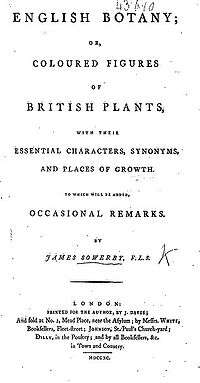English Botany
|
Title page from the book | |
| Author | James Edward Smith |
|---|---|
| Illustrator | James Sowerby |
| Country | England |
| Language | English |
| Series | 36 Volumes |
| Subject | Botanical publication |
| Publisher | James Sowerby |
Publication date | 1790 to 1813 |
| Media type | Volumes with hand coloured plates. |
English Botany is the title of a major publication of British plants, an enormous set of volumes that was issued between 1790 and 1813. The brief, but formal descriptions were supplied by the founder of the Linnean Society, James Edward Smith, and published and illustrated by the botanical illustrator and natural historian, James Sowerby.
The Periodical was published in 36 volumes over 23 years and was given the full title, English Botany or, Coloured Figures of British Plants, with their Essential Characters, Synonyms and Places of Growth, the descriptions supplied by Sir James E. Smith were illuminated by Sowerby's 2,592 hand-colored plates. The volumes were issued by subscription, as a part work over 23 years, until its eventual completion in 1813. This amounted to 36 volumes which came to be referred to 'Sowerby's Botany', though somewhat erroneously.
While extensive, the work was never intended to be comprehensive; Smith would be the first to do such a survey with his first two volumes of Flora Britannica at the end of that century. The descriptions given are accurate and systematic, in the use of binomial nomenclature, with Latin and English description; but a wider audience was intended with digression into general discussion and cultivation. Combined with increased sales of books, and the amateurs and gardeners enthusiasum for botany, the volumes were to become well known. Identification of the plants, in correspondence with the details in the plates, gave the work accuracy and utility beyond that of decorative books and more akin to formal botanical works.
Smith and Sowerby's partnering was not their only one, other early publication of Smith's descriptions with Sowerby plates, included Icones pictae plantarum rariorum descriptionibus et observationibus illustratae during 1790-93 and A Specimen of the Botany of New Holland, a survey of exotic species found in the new colonies of Australia. However, the first four volumes of English Botany came to be misattributed due to a request by Smith to remain anonymous on the title. Sowerby's name as the publisher, with a credit to himself as illustrator, allowed those enamoured by the novelety of his illustrations to perpetuate this misnomer. The title is still given in book sales as "Sowerby's".
The illustrations allowed a reader not familiar with botany to identify plants; also, the aesthetic appeal of the vivid hand coloured engravings earned Sowerby much praise. However, Smith was derisive of the ability of images alone to describe a plant. The graphics needed the formal description and explanation, without which only a 'superficial knowledge' could be gained from the text. Despite disagreement between the two men, they continued to issue the work: the absence of Smith's name in the title was corrected in later volumes and editions.
Considered to be the first extensive coverage of British flora, there was none of the kingdom Fungi. Without Smith, Sowerby added Coloured figures of English fungi, (1797–1815) for the species of this domain. Later editions of the book were to take advantage of a mechanical colour printing, further increasing the affordability of the book. The third edition in 1883 saw editor John Boswell alter the text and include a "popular portion".
Plates
.jpg) Hand coloured plate Crocus nudfloris by James Sowerby
Hand coloured plate Crocus nudfloris by James Sowerby Hand coloured plate of Convolvulus soldanella (see Convolvulus), Sea Bindweed
Hand coloured plate of Convolvulus soldanella (see Convolvulus), Sea Bindweed
References
| Wikimedia Commons has media related to English Botany. |
- Walsh, Huber M. (2003). "James Sowerby". Rare book - Authors. Missouri Botanical Garden. Retrieved 2007-07-26.
Unlike other flower painters of the time, whose work tended toward pleasing wealthy patrons, he worked directly with scientists.
- Robert Erickson. "Smith, James Edward". Authors. Botanicus. Retrieved 2007-07-25.
- "Sir J.E. Smith (1759-1828)". Home > History > Sir J. E. Smith. Linnean Society of London. Retrieved 2007-07-27.
In 1790, Smith started on his first major work, English Botany, which brought him the acquaintance of leading botanists.
- Exhibition curator: Hugh Cahill (2006-05-10). "The British flora described". NATURE OBSERVED: THE WORK OF THE BOTANICAL ARTIST: An exhibition of books from the Foyle Special Collections Library. King's College London. pp. Case 4:. Archived from the original on 2009-06-01. Retrieved 2007-07-27.
However, it did not describe the fungi of Britain and so Sowerby published Coloured figures of English fungi (1797-1815) to accompany it, for which he provided both the text and the plates.
